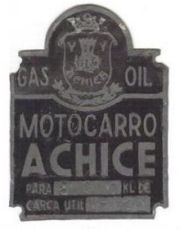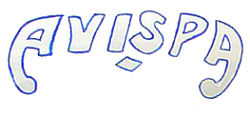

Notes on some of the rarer Spanish marques
This page lists brands for which we currently have only an historical precis. For a more complete listing visit the Spanish Index.
A.Badia
Built by Antonio Badia in Palautordera, 1928, this was a 100cc racing motorcycle.
There was also a V. Badia active in Barcelona after WWII.
Source: OTTW
Abad 1940~1969

Achice
Manufactured in Murcia from 1951 to 1996, the firm built motorcycles and motocarro using Hispano Villiers engines, and in some cases Minsel. Founded by Andrés Chinchilla Cerezo, one of the firm's clients was Cartagena City Council, to whom they supplied tipper trucks for garbage collection. Later machines had four wheels.
Sources: OTTW, Autopasion18.com
Acedo
Autos Acedo of Madrid manufactured a microcar which was presented at the Retiro in Madrid in November 1941. At that time quality materials were in short supply, and the performance of the machine was poor.
The prototype machine was a tricycle with a single rear wheel, with the body resembling the fuselage of an aeroplane. It was powered by their own single-cylinder ACEDO P4E four-stroke engine of 2.2 h.p.
The company was founded by Ramón Acedo and the vehicle was designed by Antonio Jurado. Several images illustrate a machine with four wheels.
Sources: OTTW, Autopasion18.com.
ADP
Built in Madrid by Angel de Pozo in the 1980s this was a GP racer fitted with a Derbi 125 engine.
Source: OTTW
Aida
In 1955 production was planned for a motorcycle but it did not get to prototype stage.
Source: OTTW
AISA 1950s
AJR
Built in La Garriga, Barcelona, these are replicas of famous racing machines such as the Bultaco TSS. The first machines appeared in 1994 and the company has thrived.
Visit AJR Motos
Alce
Scooters equipped with Narcla engines built in the early 1950s, probably in Girona. One of these is in the Sala Santy Collection.
Alce 125cc Scooter
Source: OTTW
Alonso
Built in the early 1950s, these were autocycles fitted with 48cc Ducati Cucciolo T2 engines.
Source: OTTW
Alpha 1924-1957
Altosen
The firm built Gnome & Rhône engines under licence in Barcelona during the 1950s.
Source: wikipedia.ca
AMF
A.M.F. were built in Barcelona 1951-1955
These were mopeds powered by Iresa and Cucciolo engines, along with tricycles and off-road motorcycles using engines from Hispano Villiers, OSSA and Pons.
Source: wikipedia.es.
An-Bar
Don Pedro de Luna, 6 and Zapata, 6, Zaragoza
Antonio Barbacil, owner of the Barbacil firm, manufactured 98cc and 123cc two-stroke engines modelled on the Villiers in the years 1948 to 1953.
These were built in the Barbacil factory, and were also built by Dian of Barcelona under the direction of A. Barbacil. Dian manufactured Betor suspension.
Source: OTTW.
Antras 1901
Anvian 1980-1982
Arbizu
Manufactured by Toni Gutierrez Arbizu in Terrassa, Vallès Occidental, 1981-1989
These were roadracing machines using components from Siroko and Rotax. In 1989 Arbizu began working with Metrakit of Italy.
Sources: wikipedia.es, et al.
ARC 1954-1955
Ardilla 1950-1952
ArianeTech
Based in Madrid, ArianeTech built Moto2 and Moto3 racing motorcycles named Ariane from 2011 to 2015, and have developed numerous road a racing projects for major manufacturers including Rieju, Yamaha, Derbi and Hero. They have also created very attractive pocket racers.
Website: arianetech.net
Arisco
Miquel Tàpies built 230cc road racers based on his MTK kart engines (Miquel Tàpies Karts) from 1977 to 1980. Early models had air-cooled engines, later water-cooled. The aim was to provide a cheaper alternative to the Yamaha for privateers.
Source: Mike Ricketts
A.R.M. 1982-1989
Arteman 1954-1960, Seville
Artes de Arcos 1921-1965
ASB by SB, Valencia, 1948-1963
Aster of Madrid 1954-57
Astur
Ciclomotor manufactured in Asturias from 1951 to 1953. The diminutive machine had some unusual features - belt drive ran from the engine to the extended steel rim of the rear wheel, and both the carburettor and the exhaust were located at the front of the four-stroke engine.
Sources: OTTW, et al.
Audenis 1930-1936

Autisa
Manufactured competition motorcycles in Les Franqueses del Vallès during the 1980s, and ran an 80cc road-racing team. The firm also offered tuning kits.
Source: wikipedia.es
Avia Motocarro, 1960s

Avispa
Light motorcycles thought to have been built in Valencia in the 1940s and 50s. Fitted with a 98cc two-stroke, an example of the Avispa (EN: Wasp) has been displayed at the Museo de la Motocicleta Española, Madrid.
Sources: wikipedia.es